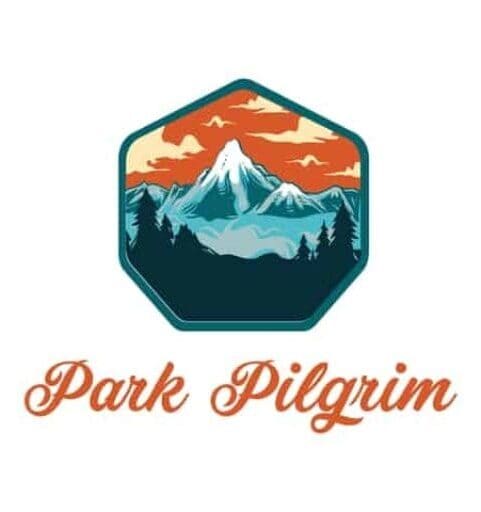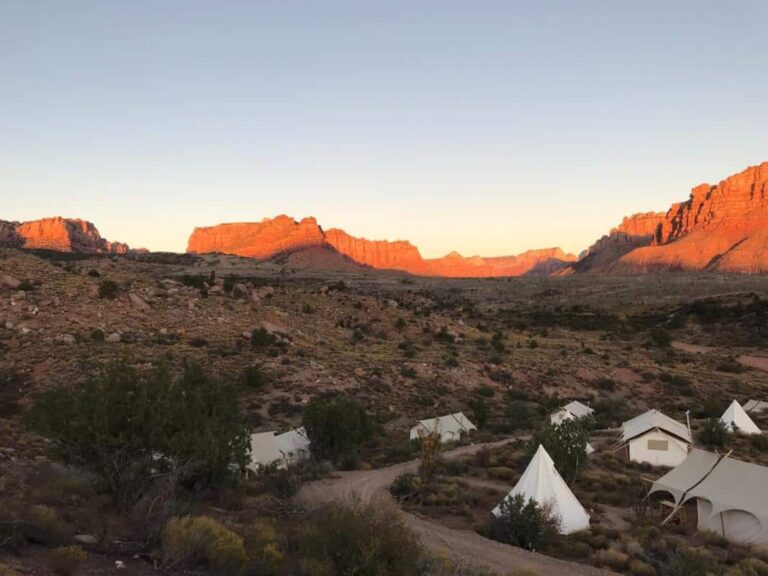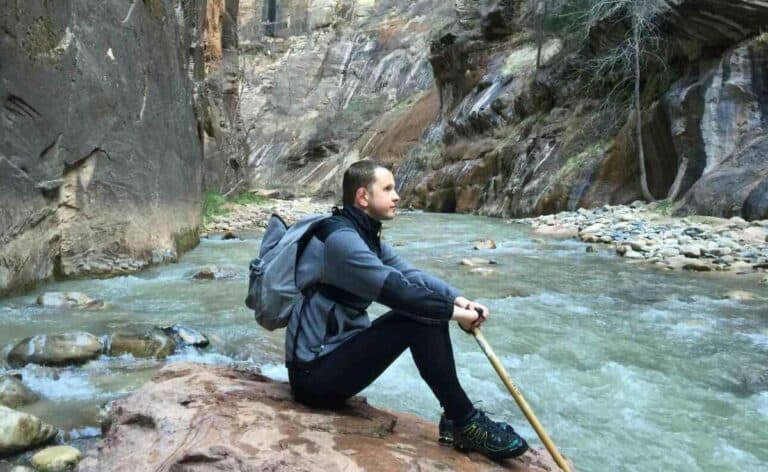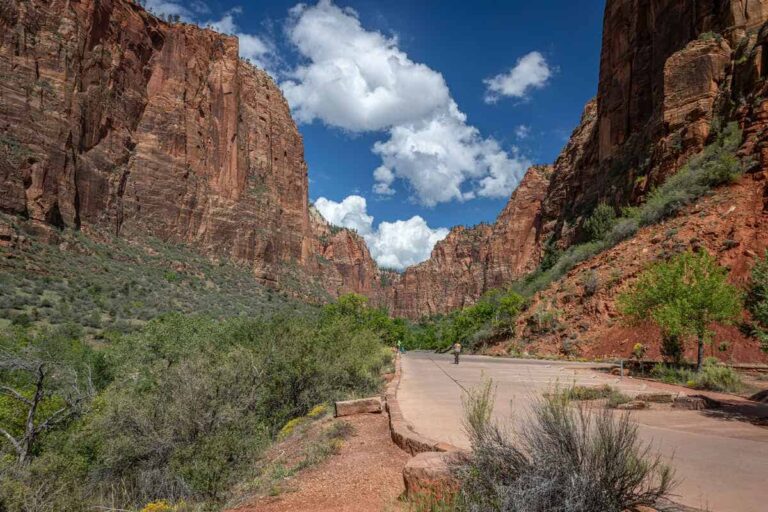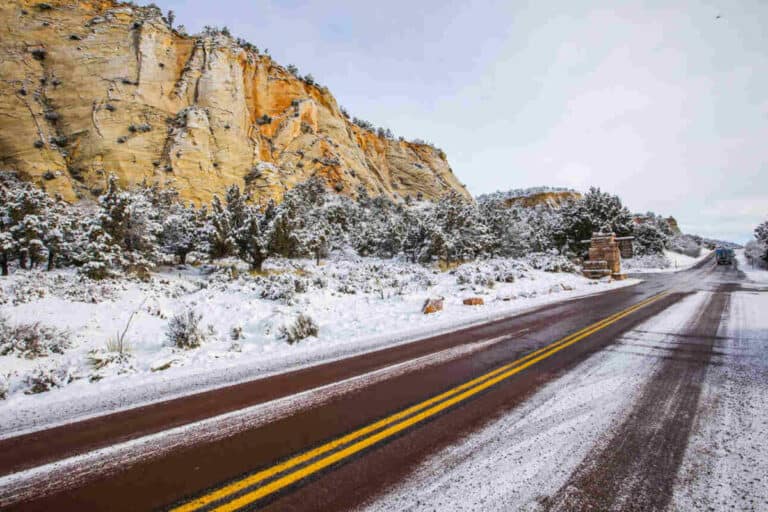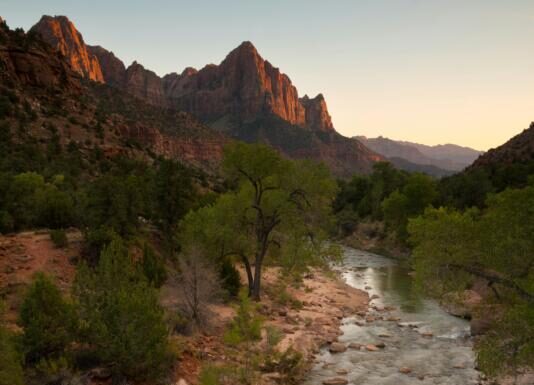Complete Guide to Zion’s Entrances – Including The Roads Less Traveled
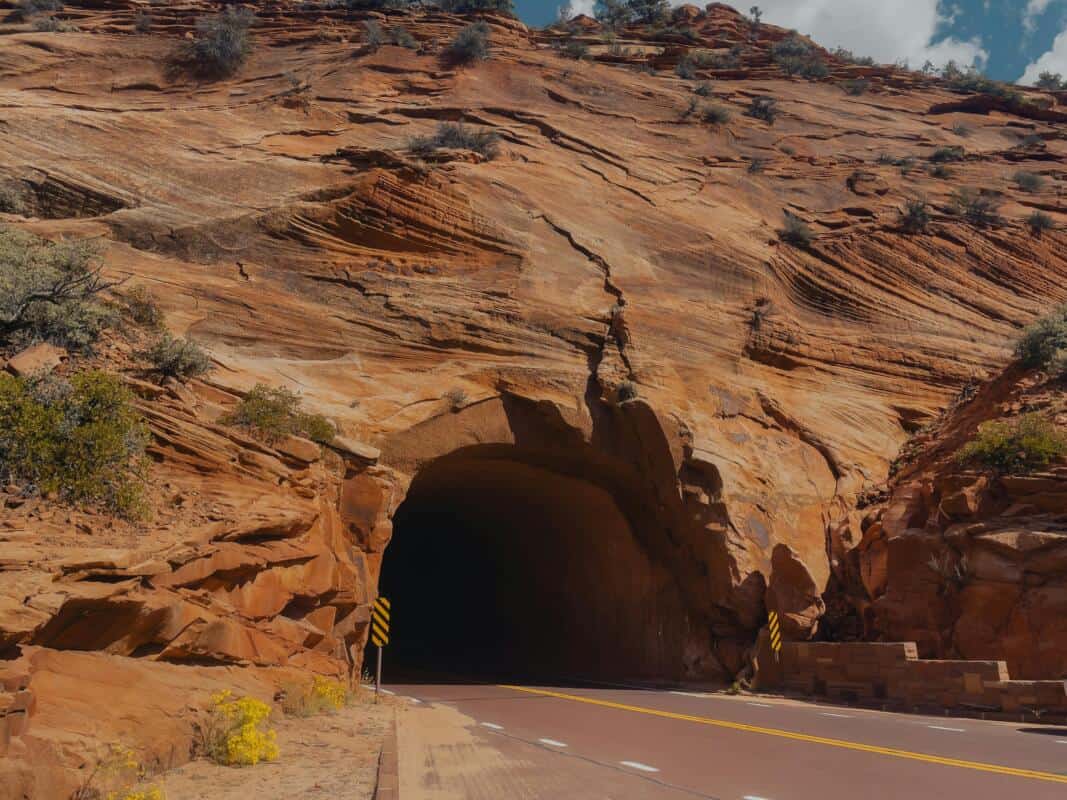
If you’re planning a trip to Zion National Park, you’ve probably already seen many, MANY stunning photos of towering red rocks and narrow canyons. But here’s what nobody tells you: how you get into the park can make or break your entire experience.
I’ve seen too many visitors show up with their perfect itinerary only to find themselves stuck in a three-hour line at the South Entrance during peak season — or worse, arriving at the East Entrance in an RV without realizing they can’t fit through the tunnel.
So let’s avoid that mess, shall we?
The Four Ways Into Zion: Not All Entrances Are Created Equal
You know what’s funny? Most people don’t even realize Zion has four different ways to enter. Each has its own personality, crowd levels, and quirks. Here’s the real deal on each:
South Entrance: The People’s Choice (For Better or Worse)
This is the entrance everyone knows about — and yeah, that’s the problem.
- Highway: UT-9, also called the Zion-Mt. Carmel Highway
- Connects from: I-15 at Exit 16 in Washington, Utah
- Passes through: Hurricane, La Verkin, Virgin, and finally Springdale
The South Entrance is basically Zion’s front door, complete with the full welcome mat: visitor center, shuttle service during peak season (typically early March-late November), hotels, restaurants, and gift shops galore in Springdale.
If you’re a first-timer, this entrance makes sense — everything’s convenient and well-marked.
But here’s the thing…
During summer months and holiday weekends, the line of cars can back up for miles. I’m not exaggerating when I say people have waited hours just to get through the entrance station.
You know what’s even worse? Finding out all parking is full once you finally make it through.
Pro tip: If you’re using this entrance between May and September, either arrive before 8am or after 3pm. Or better yet, park in Springdale and take the free town shuttle to the park entrance.
East Entrance: The Scenic Route With a Catch
- Highway: Also UT-9 (Zion-Mt. Carmel Highway), but from the other direction
- Connects from: US-89 at Mt. Carmel Junction
- The catch: The Zion-Mt. Carmel Tunnel
The East Entrance is frankly more dramatic. You’ll wind down through colorful sandstone formations and pass through the historic Zion-Mt. Carmel Tunnel, which was the longest tunnel in the U.S. when it was completed in 1930. The views as you emerge are spectacular — but there’s a major ‘gotcha’ here.
That tunnel? It has size restrictions that will ruin your day if you’re in a larger vehicle:
- Vehicles over 13’1″ in height? Sorry, you can’t pass. Period.
- Driving something wider than 7’10” or taller than 11’4″? You’ll need a $15 tunnel permit, and they’ll stop traffic in both directions so you can drive down the middle.
- Oh, and if your vehicle is longer than 40 feet? You’re out of luck too.
And just to make things more fun, rangers have to manually measure oversized vehicles that might be close to these limits, which can cause significant delays.
Who should use this entrance: If you’re coming from Bryce Canyon, Grand Staircase-Escalante, or Lake Powell, and you’re in a normal-sized vehicle, this is a gorgeous way to enter the park.
Kolob Canyons Entrance: The Hidden Gem
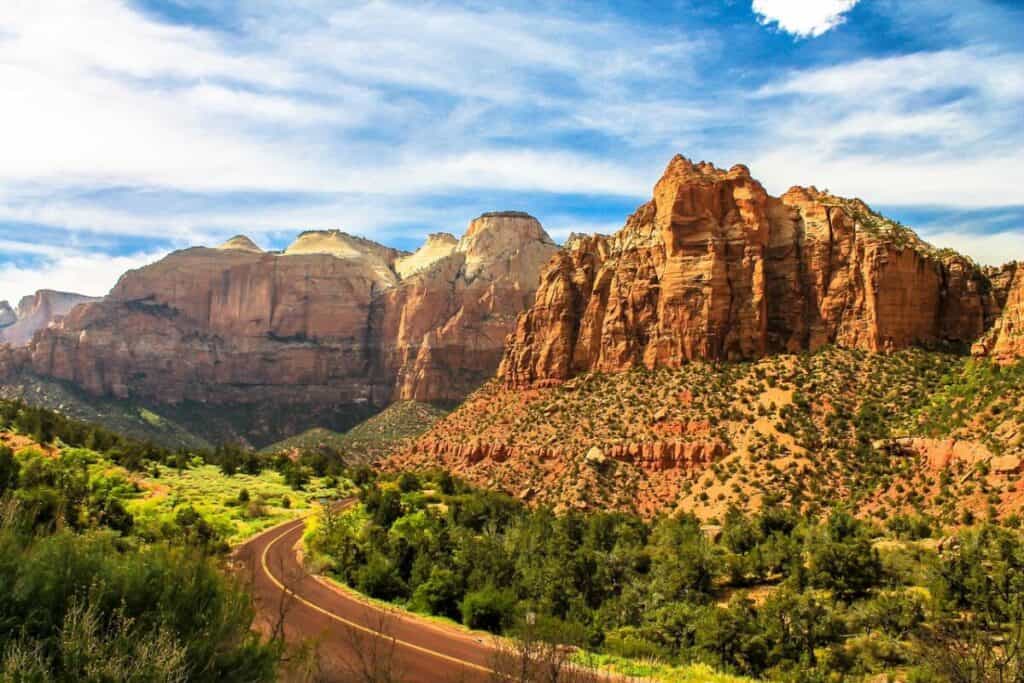
- Highway: I-15, Exit 40
- Location: 40 miles north of St. George, 20 miles south of Cedar City
Here’s what nobody tells you: some of Zion’s most spectacular scenery isn’t even in the main canyon. The Kolob Canyons section sits in the northwest corner of the park, completely separate from the main canyon, with its own entrance directly off I-15.
This area feels like a different park altogether — and in the best way possible. The crimson canyons here are just as impressive, but the crowds? Maybe 5% of what you’ll find at the South Entrance. It has its own small visitor center and a gorgeous 5-mile scenic drive with several pullouts and a few excellent trails.
Why more people don’t use it: It doesn’t connect to the main canyon by road. You can’t get to Angels Landing or the Narrows from here, which keeps the crowds away.
Who should use this entrance: Anyone traveling I-15 between Las Vegas and Salt Lake City who wants a taste of Zion without the crowds. The Timber Creek Overlook Trail is a quick 1-mile round trip hike with views that rival anything in the main canyon.
Kolob Terrace Road: The Backdoor Most People Miss
- Road: Kolob Terrace Road
- Starts in: Virgin, Utah
- Goes to: Nowhere in particular, which is kind of the point
I hesitate to even mention this one because it’s such a well-kept secret. Technically, it’s not even considered a formal entrance, as there’s usually no entrance station — though during peak seasons, you might encounter a mobile fee collection point, so still be prepared to pay the park entrance fee.
Kolob Terrace Road winds through a remote section of Zion, climbing from the desert floor up to higher elevations with pine forests and meadows.
Along the way, you’ll find trailheads for some of Zion’s most adventurous hikes, including The Subway (permit required) and Lava Point, one of the highest elevations in the park at around 7,890 feet (though not the absolute highest — that would be Horse Ranch Mountain at 8,726 feet).
What you won’t find: visitor centers, gift shops, shuttles, or crowds. This is Zion in its natural state.
The drawback: No services means no restrooms, no water, no rangers to answer questions. You’re on your own out here, and cell service is spotty at best.
The Definitive Entrance Table: Quick Reference Guide
| Entrance | Highway(s) | From | Best For | Avoid If |
|---|---|---|---|---|
| South Entrance | UT-9 (via I-15 Exit 16) | Utah | First-time visitors, accessing the main canyon | You hate crowds or are visiting midday in summer |
| East Entrance | UT-9 (via US-89) | Utah | Scenic approach, coming from Bryce Canyon | You’re driving an oversized vehicle |
| Kolob Canyons | I-15 (Exit 40) | Utah | Escaping crowds, quick visits while passing through | You specifically want to see the main canyon attractions |
| Kolob Terrace Road | Kolob Terrace Road (from Virgin, UT) | Utah | Solitude, wilderness experience, The Subway hike | You need facilities or want ranger guidance |
Beyond the Entrances: The Realities of Getting Around
Let’s be real here… once you’ve chosen your entrance, there’s more to know about actually navigating inside Zion. Here’s what actually matters:
The Mandatory Shuttle System (Seasonal)
From typically early March through late November (exact dates vary year to year), you cannot drive your personal vehicle up Zion Canyon Scenic Drive from the South Entrance. I repeat: you CANNOT drive your car into the main canyon during peak season.
Instead, you’ll park (if you’re lucky enough to find a spot) and take the free shuttle. Shuttles run frequently — typically every 7-15 minutes — but lines can be long in summer. The shuttles make multiple stops along the scenic drive, letting you hop on and off at trailheads and viewpoints.
Exceptions to the shuttle rule:
- If you’re staying at Zion Lodge, you can drive as far as the lodge (with proof of reservation)
- During winter months (typically December-February), the shuttle doesn’t run and personal vehicles are permitted
- If you have an accessibility placard, you may qualify for a special permit
Parking: The True Limiting Factor
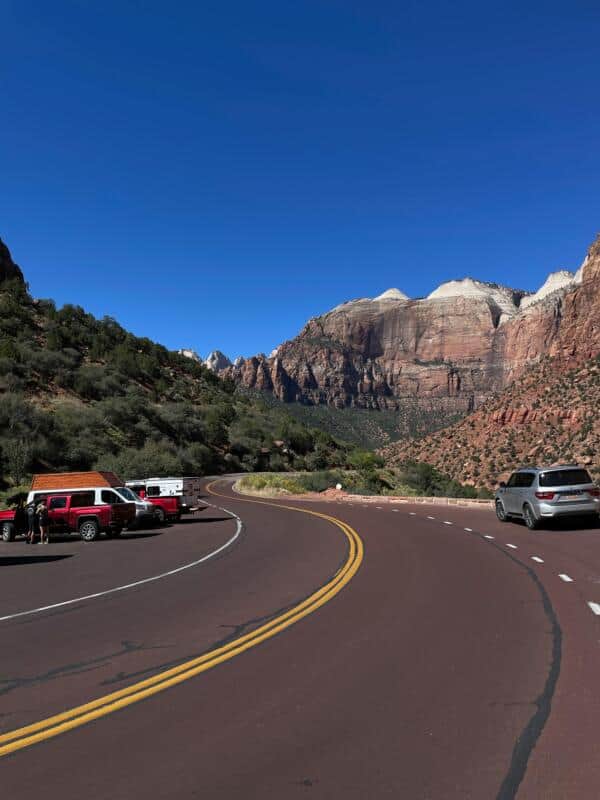
You know what stresses people out even more than the entrance lines? Finding a parking spot. The lots inside the park fill incredibly early — often before 9am in summer.
Your alternatives:
- Park in Springdale (paid lots or metered street parking) and take the free town shuttle to the park entrance
- Arrive very early (before 8am) or later in the afternoon (after 3pm) when some spots open up
- Visit during off-season (November-March, excluding holidays)
The East Side: Freedom to Roam
If you enter from the East Entrance or drive through the tunnel from the South Entrance, you’ll find yourself on the east side of the park. Here, there’s no shuttle system, and you’re free to drive and park along the road at designated pullouts.
This area has fewer established trails but more opportunities for casual exploration among the slickrock formations. It’s also generally less crowded than the main canyon.
Seasonal Considerations: Timing Is Everything
Want to really optimize your Zion entrance strategy? Think seasonally.
Summer (June-August)
Pure madness at the South Entrance. Expect lines starting at 8am and continuing until mid-afternoon. The East Entrance gets busy too, especially mid-morning. If you must visit in summer:
- Enter before 7am or after 3pm
- Consider the Kolob Canyons entrance instead
- Visit on weekdays (slightly better than weekends)
Fall (September-November)
Still busy, but not summer-level insanity. Fall colors make this a beautiful time to visit, especially in late October and early November. The shuttle system is still running, but wait times are generally shorter.
Winter (December-February)
The blessed off-season. The shuttle doesn’t run, so you can drive your own vehicle up the canyon.
Temperatures can be cold (sometimes below freezing), but the trade-off is having viewpoints nearly to yourself. The East Entrance road can occasionally close due to snow or ice, particularly at higher elevations.
Spring (March-May)
A mixed bag. Early spring can be wonderfully quiet, but as spring break and then Memorial Day approach, crowds swell again. The shuttle typically begins running in March, but exact dates vary year to year.
My Personal Take: How I’d Enter Zion
If I were planning a Zion trip tomorrow? Here’s what I’d actually do:
- If I’d never been before and wanted to see the classic sights like Angels Landing and The Narrows: South Entrance, but I’d stay in Springdale and arrive at the shuttle stop before 7am.
- If I were making a quick visit while driving between Las Vegas and Salt Lake City: Kolob Canyons entrance, no question. I’d spend 2-3 hours doing the scenic drive and one short hike, then continue my journey.
- If I were a return visitor wanting to avoid crowds: Kolob Terrace Road, bringing everything I need (water, food, first aid) and targeting one specific hike for the day.
- If I were approaching from the east (Bryce Canyon direction): East Entrance, but I’d time it for late afternoon when the light on the canyon walls is magical and the morning tour buses have departed.
The Bottom Line
Zion isn’t getting any less popular. Visitation has fluctuated in recent years, with around 4.7 million visitors in 2022 (down slightly from the 5 million in 2021), but the roads and parking lots haven’t expanded with it. Your entrance strategy can truly make or break your experience.
The South Entrance will always be the most convenient but also the most crowded. The East Entrance offers drama but comes with vehicle restrictions. Kolob Canyons provides a taste of Zion with minimal hassle. And Kolob Terrace Road remains the wild, undeveloped backdoor for those willing to plan accordingly.
Whatever entrance you choose, just remember that the extra few minutes of research you’re doing now could save you hours of frustration when you actually arrive. And that means more time for what really matters — experiencing the incredible landscapes that made Zion worthy of national park status in the first place.
Almost all tourists funnel through the South Entrance. But you don’t have to be one of the masses. Choose wisely, time your visit strategically, and you might just find yourself with a piece of Zion all to yourself.
And that is worth more than all the gift shop T-shirts in Springdale.
